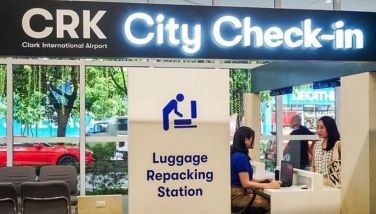1,647 RP universities, yet grads flunk tests

October 30, 2006 | 12:00am
Information on the fraudulent nursing board exam continues to pour in. Some belie official pronouncements, like a false claim of the Professional Regulation Commission that it is impossible to tell where examinees took review classes so it’s futile to pinpoint who should retake the exam.
Two nurses and a 2006 passer say it’s not impossible. For, they were told to state the review center in their application for the test and in the info sheet that accompanied the answer sheet. In effect, all the PRC has to do is check its files. But then, the PRC never wanted a retake, even by passers who apparently got leaks of questions from Gapuz, Inress and Pentagon review centers.
Speaking of Gapuz, a Filipino nurse now in America avers that the center owner had bragged that Board of Nursing examiners, "all of them lazy", usually request him to draft the exam questions. That’s why, he allegedly concluded, graduates should enroll in his center if they know what’s good for them.
Authorities talk of digging deeper than just the exam fraud. A matter begs studying: why, out of 43,000 nursing examinees, did only 17,000 pass, or barely 40 percent? That’s also the dismal passing rate for most other professional licensure exams. Clearly, the tests are too tough for new college graduates. Is it because examiners are sadists, or schools simply are not up to it?
Incredibly the Philippines has 1,647 colleges and universities for a population of 80 million. If you think that’s few, consider that Australia, with a population of 20 million, has only 37. Australia ranks among the most developed economies, owing to its steel industry and high technology – products obviously of its higher education institutions (HEIs). By contrast, the Philippines cannot even produce sturdy hammers and nails, for obviously its HEIs are below global higher education standards (HES).
Good education clearly is not a contest of higher school numbers. If Australia had a population of 80 million, it probably would have four times more colleges and universities, or 148 – but still less than a tenth of the Philippines’ 1,647.
Filipino IT and business outsourcing leaders consider India the stiffest competitor. India’s population is 13 times more than RP’s. Its number of HEIs is 8,407, only five times more that in RP. The richest country in the region is Japan, with a population of 128 million, or a little over 1-1/2 times RP’s. It has 1,223 colleges and universities, less than RP’s 1,647. Japan incidentally has 0ne doctorate degree holder for every 500 population, or 256,000 in all; RP has about 60,000 max.
Did we inherit out penchant for universities from colonial masters? America has a population of 300 million, more than three times RP’s. Its number of HEIs is 5,758, also more than three times RP’s. Spain has a population of 40 million, half of RP’s. Its colleges and universities number 1,415, close to RP’s 1,647. But then, why is America the hardiest economy in the world, and Spain the fastest growing in Europe?
Other statistics are worth noting. Of the Philippines’ 1,647 HEIs, 11 are so-called state universities and colleges (SUCs) that receive government subsidies. The 1,536 are private, many run by Catholic orders.
Before it closed shop, Asiaweek magazine used to rank the continent’s top 100 universities in terms of investments on laboratories, libraries and faculty staff, plus quality of graduates. Only three RP schools landed in it twice, with declining rankings from the 50s to the 70s: University of the Philippines, Ateneo de Manila University, and De La Salle University.
Authorities might want to assess if a thousand or so of RP’s HEIs need to be closed down, but with the remaining encouraged to expand.
Education Secretary Jesli Lapus says the poor performance of college grads in licensure exams can be traced back to elementary and high schools. A remedy is obviously to improve primary and secondary education.
Three of every four children are in public schools. So the focus must be on them. Recent performances are discouraging. Only seven of every thousand graduates of Grade 6 are ready for the rigors of high school. Only one in ten high school graduates is equipped for college Science, Math and English. In a test of school learning among 40 countries, Filipino Grade 4 and 2nd-Year students landed at the bottom in Math and Science.
Send them to college and most will be wasting the family’s savings.
The great Filipino dream is to earn a college degree and live happily ever after. It doesn’t work that way; it doesn’t have to be that way. High school should be able to train graduates for gainful employment. Scholars with the aptitude and scions with the affluence can move on to college for higher learning and specialization. It can be done, as in the recent success of public schools in Canada’s province of Alberta.
Many Canadians love to put down Albertans as "loutish rednecks who have the dumb luck to be sitting on pools of oil and natural gas," the Economist magazine reported in Sept. But the thing to envy about Alberta is not its roaring economy but its investment in education.
Alberta’s students often outshine those of other provinces because of a slew of reforms. For one, schools regularly test scholastic achievements of students at Grades Three (aged 7-8), Six (10-11) Nine (13-14) and Twelve (16-17). That way they are able to track overall performance and at the same time spot slow learners in need of closer teacher attention. Emphasis is of course on Math, Science and Reading-Writing; the first two are platforms for higher subjects, while the last two hone comprehension and search for more knowledge. The province pours money of course to recruit and train more principals and teachers, and build more classrooms.
Some innovations also led to better management. Schools were given control over their own funds, so long as free choice, competitiveness and accountability reigned. Students were free to go to any school, not just in their neighborhoods. They were encouraged to seek their interests: arts, sciences, languages, or sports. In some schools, particularly in the capital of Edmonton, students are tested yearly for achievement or counseling.
So while parents in British Columbia and Ontario are packing their kids off to private schools, the reverse is happening in Alberta. Students are moving from private to public schools for better quality education.
The booming economy makes high school grads readily employable as lorry drivers in oil drilling, at C$60,000 (P2.65 million) a year.
E-mail: [email protected]
Two nurses and a 2006 passer say it’s not impossible. For, they were told to state the review center in their application for the test and in the info sheet that accompanied the answer sheet. In effect, all the PRC has to do is check its files. But then, the PRC never wanted a retake, even by passers who apparently got leaks of questions from Gapuz, Inress and Pentagon review centers.

Speaking of Gapuz, a Filipino nurse now in America avers that the center owner had bragged that Board of Nursing examiners, "all of them lazy", usually request him to draft the exam questions. That’s why, he allegedly concluded, graduates should enroll in his center if they know what’s good for them.
Incredibly the Philippines has 1,647 colleges and universities for a population of 80 million. If you think that’s few, consider that Australia, with a population of 20 million, has only 37. Australia ranks among the most developed economies, owing to its steel industry and high technology – products obviously of its higher education institutions (HEIs). By contrast, the Philippines cannot even produce sturdy hammers and nails, for obviously its HEIs are below global higher education standards (HES).
Good education clearly is not a contest of higher school numbers. If Australia had a population of 80 million, it probably would have four times more colleges and universities, or 148 – but still less than a tenth of the Philippines’ 1,647.
Filipino IT and business outsourcing leaders consider India the stiffest competitor. India’s population is 13 times more than RP’s. Its number of HEIs is 8,407, only five times more that in RP. The richest country in the region is Japan, with a population of 128 million, or a little over 1-1/2 times RP’s. It has 1,223 colleges and universities, less than RP’s 1,647. Japan incidentally has 0ne doctorate degree holder for every 500 population, or 256,000 in all; RP has about 60,000 max.
Did we inherit out penchant for universities from colonial masters? America has a population of 300 million, more than three times RP’s. Its number of HEIs is 5,758, also more than three times RP’s. Spain has a population of 40 million, half of RP’s. Its colleges and universities number 1,415, close to RP’s 1,647. But then, why is America the hardiest economy in the world, and Spain the fastest growing in Europe?
Other statistics are worth noting. Of the Philippines’ 1,647 HEIs, 11 are so-called state universities and colleges (SUCs) that receive government subsidies. The 1,536 are private, many run by Catholic orders.
Before it closed shop, Asiaweek magazine used to rank the continent’s top 100 universities in terms of investments on laboratories, libraries and faculty staff, plus quality of graduates. Only three RP schools landed in it twice, with declining rankings from the 50s to the 70s: University of the Philippines, Ateneo de Manila University, and De La Salle University.
Authorities might want to assess if a thousand or so of RP’s HEIs need to be closed down, but with the remaining encouraged to expand.
Three of every four children are in public schools. So the focus must be on them. Recent performances are discouraging. Only seven of every thousand graduates of Grade 6 are ready for the rigors of high school. Only one in ten high school graduates is equipped for college Science, Math and English. In a test of school learning among 40 countries, Filipino Grade 4 and 2nd-Year students landed at the bottom in Math and Science.
Send them to college and most will be wasting the family’s savings.
Many Canadians love to put down Albertans as "loutish rednecks who have the dumb luck to be sitting on pools of oil and natural gas," the Economist magazine reported in Sept. But the thing to envy about Alberta is not its roaring economy but its investment in education.
Alberta’s students often outshine those of other provinces because of a slew of reforms. For one, schools regularly test scholastic achievements of students at Grades Three (aged 7-8), Six (10-11) Nine (13-14) and Twelve (16-17). That way they are able to track overall performance and at the same time spot slow learners in need of closer teacher attention. Emphasis is of course on Math, Science and Reading-Writing; the first two are platforms for higher subjects, while the last two hone comprehension and search for more knowledge. The province pours money of course to recruit and train more principals and teachers, and build more classrooms.
Some innovations also led to better management. Schools were given control over their own funds, so long as free choice, competitiveness and accountability reigned. Students were free to go to any school, not just in their neighborhoods. They were encouraged to seek their interests: arts, sciences, languages, or sports. In some schools, particularly in the capital of Edmonton, students are tested yearly for achievement or counseling.
So while parents in British Columbia and Ontario are packing their kids off to private schools, the reverse is happening in Alberta. Students are moving from private to public schools for better quality education.
The booming economy makes high school grads readily employable as lorry drivers in oil drilling, at C$60,000 (P2.65 million) a year.
BrandSpace Articles
<
>
- Latest
- Trending
Trending
Latest
Trending
Latest
Recommended























